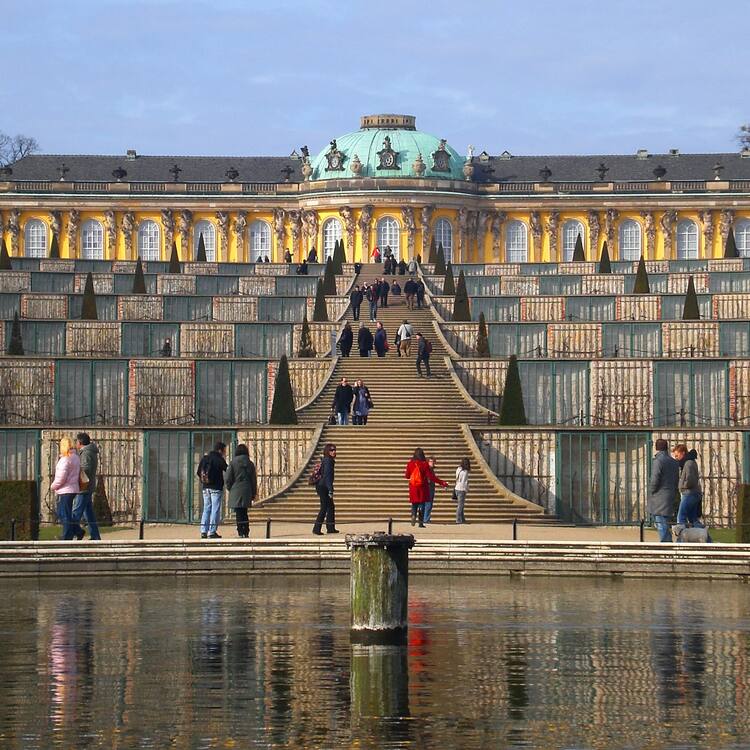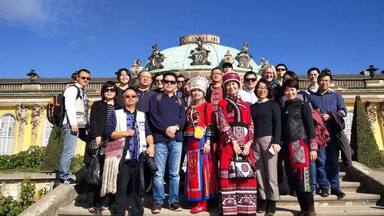Palaces and Parks of Potsdam and Berlin
Palaces and Parks of Potsdam and Berlin
With 500 ha of parks and 150 buildings constructed between 1730 and 1916, Potsdam's complex of palaces and parks forms an artistic whole, whose eclectic nature reinforces its sense of uniqueness. It extends into the district of Berlin-Zehlendorf, with the palaces and parks lining the banks of the River Havel and Lake Glienicke. Voltaire stayed at the Sans-Souci Palace, built under Frederick II between 1745 and 1747.
Description is available under license CC-BY-SA IGO 3.0
Châteaux et parcs de Potsdam et Berlin
Avec ses 500 ha de parcs, ses 150 constructions édifiées entre 1730 et 1916, l'ensemble des châteaux et parcs de Potsdam constitue une entité artistique exceptionnelle dont le caractère éclectique renforce l'unicité. Cet ensemble est prolongé, dans le district de Berlin-Zehlendorf, par les châteaux et les parcs qui s'étendent sur les rives de la Havel et du lac de Glienicke. Voltaire séjourna dans le palais de Sans-Souci, construit sous Frédéric II entre 1745 et 1757.
Description is available under license CC-BY-SA IGO 3.0
قصور وحدائق بوتسدام وبرلين
إن مجموعة القصور والحدائق في بوتسدام التي تتألف من 500 هكتار و 150 مبنى تمّ تشييدها بين 1730 و 1916 تشكل كياناً فنياً استثنائياً يزيد طابعها النيّر من فرادتها. وكامتداد لهذه المجموعة الواقعة في منطقة برلين- زهليندورف، تأتي القصور والحدائق الواقعة على ضفاف الهافل وبحيرة غلينيكي. وقد سكن فولتير قصر (سان سوسي) الذي بناه فريديرك الثاني بين عامَي 5471و7571.
source: UNESCO/CPE
Description is available under license CC-BY-SA IGO 3.0
波兹坦与柏林的宫殿与庭园
拥有500公顷的公园和150座1730年至1916年期间的建筑物,波兹坦宫殿和庭园共同构成了一个艺术整体,其折衷性强化了其独特性。遗址一直延伸到柏林-采伦多夫区(Berlin-Zehlendorf),其间的宫殿和庭园把哈弗尔河(River Havel)和格列尼克湖(Lake Glienicke)连接起来。位于桑图谢-苏西宫殿(Sans-Souci Palace)的伏尔泰宫是1745年至1747年期间弗雷德里克二世(Frederick II)在位期间修建的。
source: UNESCO/CPE
Description is available under license CC-BY-SA IGO 3.0
Дворцы и парки Потсдама и Берлина
500 га парков и 150 сооружений, построенные между 1730 и 1916 гг. и составляющие дворцово-парковый комплекс Потсдама, представляют собой единое художественное целое, эклектичный характер которого еще более усиливает его уникальность. Комплекс продолжается в округе Берлин-Целендорф, где дворцы и парки располагаются вдоль берегов реки Хавель и озера Гленике. Во дворце Сан-Суси, построенном во времена правления Фридриха II в 1745-1747 гг., останавливался Вольтер.
source: UNESCO/CPE
Description is available under license CC-BY-SA IGO 3.0
Palacios y parques de Potsdam y Berlín
Las 500 hectáreas de parques y las 150 edificaciones palaciegas de Potsdam, construidas entre 1730 y 1916, forman un conjunto artístico cuyo eclecticismo contribuye a reforzar su singularidad. Este conjunto se extiende también por el distrito de Berlín-Zehlendorf, constelado de edificios y jardines situados a orillas del río Havel y el lago Glienicke. El filósofo francés Voltaire residió en uno de ellos, el Palacio de Sans-Souci, construido por orden de Federico II entre 1745 y 1747.
source: UNESCO/CPE
Description is available under license CC-BY-SA IGO 3.0
ポツダムとベルリンの宮殿群と公園群
首都ベルリンとその郊外のポツダムには、18世紀~19世紀につくられた公園や宮殿が多数あり、16世紀末に建てられたこのシャルロッテンブルグ宮殿などの多くの史跡がある。「新宮殿」は、18世紀の啓蒙専制君主として名高いプロイセン王フリードリヒ2世が、典雅なロココ様式の離宮「サン・スーシー」に次いで建造した、後期バロック様式の豪壮な宮殿。「プロイセンのヴェルサイユ」ともいわれている。source: NFUAJ
Paleizen en parken in Potsdam en Berlijn
Het complex van paleizen en parken in Potsdam vormt een artistiek geheel, waarvan het eclectische karakter het gevoel van uniciteit versterkt. Het strekt zich uit tot de wijk Berlijn-Zehlendorp, met de paleizen en parken langs de oevers van de Havel en het Glienicke meer. Het complex omvat 500 hectare en er zijn 150 gebouwen uit de periode 1730 en 1916. Onder het regime van Frederik II de Grote (1712-1786) is Potsdam radicaal veranderd, hij wilde het tot een Pruisisch Versailles maken. Voltaire verbleef in het paleis Sans-Souci, dat Frederik II tussen 1745 en 1747 liet bouwen.
Source: unesco.nl
Outstanding Universal Value
Brief synthesis
The Palaces and Parks of Potsdam and Berlin (Sanssouci) represent a self-contained ensemble of architecture and landscape gardening in the 18th and 19th centuries. This ensemble, having an outstanding artistic rank, has its origin in the work of the most significant architects and landscape gardeners of their time in Northern Germany - G.W. von Knobelsdorff (1699-1753), C. von Gontard (1731-1791), C.G. Langhans (1732-1808), K.F. Schinkel (1781-1841), P.J. Lenné (1789-1866) and their co-operators. Together with highly imaginative sculptors, painters, craftsmen, building workers, and gardeners, they created Sanssouci, the New Garden, the Park of Babelsberg, and other grounds in the surrounding area of Potsdam as an overall work of art of high quality, European rank, and international standing.
The World Heritage property enfolds the Palaces and Parks of Potsdam and Berlin including buildings, parks, and designed spaces, which are intuitively, territorially and historically aligned with Sacrow Castle and Park and the Sauveur Church.
The cultural landscape with its parks and buildings was designed and constructed between 1730 and 1916 in a beautiful region of rivers, lakes, and hills. The underlying concept of Potsdam was carried out according to Peter Joseph Lenné’s plans, which he designed after the mid-1800s, to transform the Havel landscape into the cultural landscape it is today. These designs still determine the layout of Potsdam’s cultural landscape. The ensemble of parks of Potsdam is a cultural property of exceptional quality. It forms an artistic whole, whose eclectic nature reinforces its sense of uniqueness.
In Potsdam, the World Heritage property includes Sanssouci Park, the Lindenallee Avenue west of the New Palace, the Former Gardener’s Training School, former Railway Station of the Emperor and its environs, Lindstedt Palace and its low-lying surroundings, the Seekoppel paddock, the Avenue to Sanssouci, the Voltaireweg Avenue as a connection between Sanssouci Park and the New Garden, the New Garden, the so-called Mirbach Wäldchen Grove and the link between Pfingstberg Hill and the New Garden, the Villa Henkel with Garden, Pfingstberg Hill, the garden at the Villa Alexander, Babelsberg Park, the approaches to Babelsberg Park, the Babelsberg Observatory, Sacrow Park, the Royal Forest around the village of Sacrow, and the Russian colony Alexandrowka with the Kapellenberg, the artificial Italian village of Bornstedt and the artificial Swiss village in Klein-Glienicke. In Berlin, it includes Glienicke Park, Böttcherberg Hill with the Loggia Alexandra, the Glienicke Hunting Lodge, and the Peacock Island (including all buildings).
Criterion (i): The ensemble of the Palaces and Parks of Potsdam is an exceptional artistic achievement whose eclectic and evolutive features reinforce its uniqueness: from Knobelsdorff to Schinkel and from Eyserbeck to Lenné, a series of architectural and landscaping masterpieces have been built within a single space, illustrating opposing and reputedly irreconcilable styles without detracting from the harmony of a general composition that has been designed progressively over time. The beginning of the construction of Friedenskirche in 1845 is a symbol of deliberate historicism: this "Nazarene" pastiche of San Clemente Basilica in Rome commemorates the laying, on 14 April 1745, of the first stone for Sanssouci, the Rococo palace par excellence.
Criterion (ii): Potsdam-Sanssouci - frequently called the "Prussian Versailles" - is the crystallization of a great number of influences from Italy, England, Flanders, Paris, and Dresden. A synthesis of art trends in European cities and courts in the 18th century, the castle and the park offer new models that have greatly influenced the development of the monumental arts and the organization of space east of the Oder.
Criterion (iv): Potsdam-Sanssouci is an outstanding example of architectural creations and Landscaping development associated with the monarchic concept of power within Europe. By the vastness of the program, these royal ensembles belong to the very distinct category of princely residences, such as Würzburg and Blenheim (included on the World Heritage List in 1981 and 1987 respectively). The bombing of 14 April 1945 has made it impossible to nominate to the World Heritage List the urban ensemble developed by Frederick William I in two stages: the "first new town", from 1721 to 1725, and the "second new town", beginning in 1733.
Integrity
The Palaces and Gardens in Potsdam and Berlin include all elements necessary to express the Outstanding Universal Value of the Prussian residence landscape. It is of adequate size to ensure the features and processes, which convey the significance of the property.
Authenticity
The history occurring between 1939 and 1989 left its mark on the Potsdam property through neglect, collective re-use of buildings, and the construction of military facilities, though the layout still follows Lenné’s plan.
The policies of the Federal States of Brandenburg and Berlin, the City of Potsdam, and the Prussian Palaces and Gardens Foundation Berlin-Brandenburg are aimed at restoring the property, based on extensive historical research and emphasizing the historical structure and layout of the planned landscape, while forming the framework for new environmental and urban developments. This guarantees conscientious and responsible restoration and renovation. Partial reconstruction does occur at times, but this is also based on intensive preliminary studies and research.
Protection and management requirements
The entire territory is classified as a monumental area according to the Brandenburg State Law on the Protection of Monuments, dated 24 May 2004, and is protected by the Statutes for the Protection of the Monumental District of the Berlin-Potsdam cultural landscape according to the UNESCO World Heritage List, administrational district of Potsdam Monumental Districts Statutes dated 30 October 1996.
The property is also covered by the State Treaty on the establishment of the Berlin-Brandenburg Prussian Palaces and Garden Foundation’s "Constructional guiding plans of the City of Potsdam" and the "State Treaty about the establishment of the “Berlin-Brandenburg Prussian Palaces and Garden Foundation” (Stiftung Preußische Schlösser und Gärten Berlin-Brandenburg, so-called SPSG) dated 23 August 1994 / 4 January1995 / published 9 January1995. The number of visitors allowed into the palaces, other buildings (museums), and parks depends on conservation and preservation guidelines.
The "Town Planning Situation/Planning Intentions" paragraphs of the nomination put considerable emphasis on the plans for Potsdam’s environmental planning (Leitplanung für die städtebauliche Entwicklung der Umgebungsbereiche der Welterbestätte Potsdam, so-called Leitplanung), which was drawn up in 1998/1999. The final environmental planning documents (Leitplanung) were passed by the City Council in 2005 and are subject to continuous improvement. A contract about the buffer zone for the World Heritage property on the territory of the town of Potsdam was signed on 27 January 2011 by the Federal State of Brandenburg, the City of Potsdam, the State Office of preservation of historical monuments, and the Prussian Palaces and Gardens Foundation Berlin-Brandenburg to ensure the lasting protection and sustained preservation of the visual and structural integrity of the property and its immediate surroundings. A declaration in respect of the buffer zone for the World Heritage property on the territory of the Federal capital, Berlin, was signed on 24 November 2004. Building activities within and outside the property are regulated also by local Building Plans and regional Land Use Plans.
Conservation and construction issues are organised and managed in close cooperation between the Prussian Palaces and Gardens Foundation Berlin-Brandenburg, the City of Potsdam, the two State Offices for Historic Monuments (Brandenburg and Berlin), the Ministry for Science, Research, and Culture, and the Senate Department for Urban Development and the Environment of Berlin.
The property is managed under the responsibility of the SPSG, the City of Potsdam, and the districts of Berlin. The City of Potsdam has further designated a local site coordinator for the area of the property located within its administrative responsibility. The SPSG has detailed documentation (photographs, measurements/surveys, maps) on all park components. The SPSG has a Monuments Committee (art-historians, architects, engineers, restorers, conservators, landscape-architects) to consider fundamental measures concerning such matters as restoration issues.
Links
-
Landesdenkmalamt Berlin, Schlösser und Parks von Potsdam und Berlin (in German only)
-
Landeshauptstadt Potsdam, Das UNESCO-Welterbe in Potsdam (in English and German)
-
Palaces and Parks of Potsdam and Berlin, UNESCO World Heritage (in English only)
-
Prussian Palaces and Gardens Foundation Berlin-Brandenburg
-
 View photos from OUR PLACE the World Heritage collection
View photos from OUR PLACE the World Heritage collection
-
UNESCO Commission of Germany (in German only)
-
Potsdam Tourist Office (in English and German)




